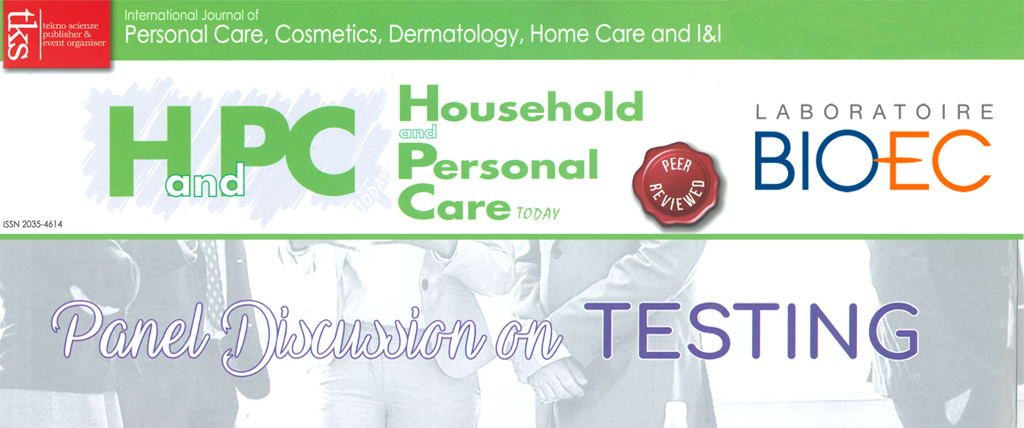Published on 11-10-2019

Editor’s note: In this issue we present a Panel Discussion on Testing. Experts from testing companies have been invited to participate around a virtual table and discuss about the more interested tests in vitro – considering safety and efficacy tests – ex vivo, silico and in vivo – concerning claims, methods and subjects. Moreover, interviewees have entered into details of the innovations they are working on to answer to customers and consumers’ needs (Tks Publisher, Gayle De Maria).
Living human skin explants is a model of excellence for testing cosmetic products
To evaluate raw materials, active ingredients used in cosmetic products or to test finished products, several biological models are available: in vitro (cell culture, etc.), ex vivo (reconstructed epidermis, living skin) and in vivo (clinical tests on volunteers).
In vitro models are mainly used at the beginning of development to select raw materials or to evaluate their toxicity. Ex vivo models are then used to confirm activity of these cosmetic ingredients, but also to test new formulations or finished products. Clinical tests on volunteers provide evidence of the efficacy of the finished product before marketing. All these models have advantages and disadvantages, but they are complementary for the development of effective cosmetics with proven safety.
Ex vivo model allows to test active ingredients or cosmetic products on human skin at the conditions closest to reality. In addition, it offers a wide variety of analytical techniques: biochemical assays, histological analyses, genomics or physical measurements. Ex vivo model was developed in the 1970s, but only 25 years later, in 1995 this technology has been proposed to test some cosmetic products by the Research Group for Dermatology and Cosmetology (Gredeco). In 1998, BIO-EC Laboratory developed its ex vivo model specifically for the cosmetic industry. For 20 years, ex vivo studies have demonstrated that explants of living human skin are a useful model in understanding the mechanisms of action of active ingredients and evaluation of finished products.
Different types of skin explants can be prepared: whole skin explants (epidermis-dermis-hypodermis), explants of normal skin (epidermis-dermis), explants of adipose tissue (hypodermis) as well as isolated hair from the scalp (figure 1).

Figure 1. Different types of explants are available for ex vivo conditions.
Being very close to the skin in vivo, the explants comprising epidermis and dermis allow to test all products intended for topical application (Figure 2). Raw materials can be tested both in a simple formulation applied on the surface of the skin explants or incorporated into the culture medium. Injectable products can be tested as well.
This variety of testable elements represents one of the major advantages of the ex vivo skin explant model compared to in vitro or reconstructed skin models.

Figure 2. Explants of living human skin (epidermis + dermis, ± 1cm²) in ex vivo conditions.
Gene expression profiling from RNA extracted from skin explants using RNA microarray technology is of particular interest for cosmetics. Indeed, it is possible to screen potential activities of an active ingredient in an experiment closest to real cutaneous physiology.
As the closest model to real skin, ex vivo explants allow to reproduce various conditions that skin faces in real life, whether it is about natural environment (climate, sun, skin flora), external aggressions (pollution, chemical irritation) or others (wounds, metabolic disorders).
This model is well suited to evaluate the majority of activities of cosmetics – hydration, sunscreen, pigmentation, anti-ageing, slimming or healing activity etc.
For over thirty years human skin explant model has been steadily improving. Thanks to the culture conditions cellular activity and tissue physiology are maintained in a functional state for about 2 weeks. Its complete biological structure cannot be questioned, making it possible to carry out studies in conditions close to reality: a good correlation exists between this model and in vivo studies. Ex vivo model allows to evaluate effects of raw materials as easily as formulations, finished products or medical devices. Explants are useful for several investigation methods such as biochemical, physicochemical, histological, microbiological or genomic analyzes.
Summarizing, ex vivo human skin is a model of choice for evaluating raw materials taking into account its absorption and diffusion into human skin and for validating a product before carrying out an in vivo study.
Entrez votre adresse email pour vous désabonner.
This message only appears when you first log